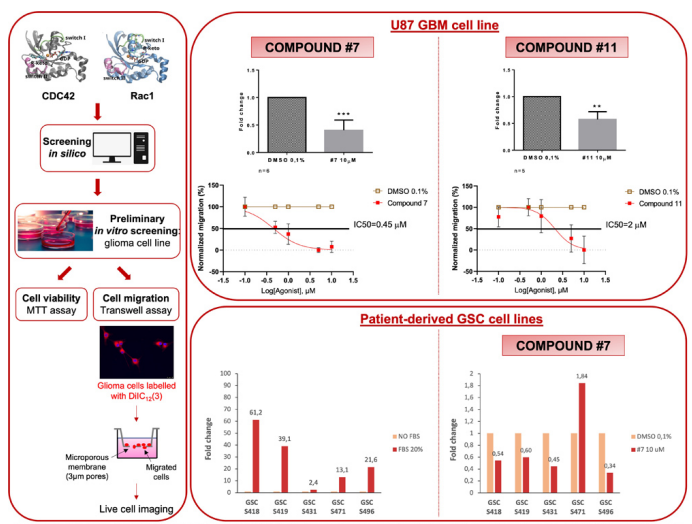PRIN2022 - Targeting glioma invasion: an additional weapon to improve therapeutic efficacy towards glioblastoma

Titolo progetto: PRIN2022 - Targeting glioma invasion: an additional weapon to improve therapeutic efficacy towards glioblastoma
Programma di finanziamento: PRIN 2022
Responsabile scientifico: prof.ssa Daniela Cesselli
Collaboratori: prof.ssa Carla di Loreto
Ruolo del DAME: coordinatore
Descrizione generale:
Despite recent progresses in understanding molecular basis of cancer pathology, high grade gliomas, such as glioblastoma (GBM), still represent a challenge in terms of therapeutic approaches. Indeed, with the current approved treatment, consisting of surgical resection followed by concomitant radio- and chemo-therapy (temozolomide), the prognosis of GBM patients remains particularly poor. The most challenging features of GBM treatment, besides the capability of drugs to reach the tumor due to the presence of the blood brain barrier (BBB), are linked to the highly infiltrative nature of tumor cells. This property resides in a specific population of cells, namely glioma stem cells (GSC), responsible for GBM resistance to treatments and recurrences. The presence of a cellular crosstalk between pro-survival and pro-invasion signaling suggests that the susceptibility to chemo- and radio-therapy could be further increased by inhibiting glioma cell invasion. Therefore, targeting the mechanisms of glioma invasion could open the way to new treatments able to revert the severe prognosis of GBM. In the present project, among the different pathways involved in cell migration, we focused on CDC42, a Rho GTPase, known as a major switch control of the rapid and dynamic reorganization of actin cytoskeleton, whose alterations have been implicated in glioma. Specifically, we will focus on two compounds, selected by in silico screenings, as acting as reversible CDC42 inhibitors, and we will assay their ability to blunt glioma cell invasion in clinically relevant experimental conditions. These latter consist of in vitro 2D and 3D model of cell invasion that take advantage of patient-derived cells to mimic as much as possible the GBM tissues. Similarly, we will employ human xenograft in vivo models. The performances of the selected compounds in our models will be evaluated in terms of (i) inhibition of tumor cell migration and invasion in 2D and 3D in vitro models, (ii) ability to reduce cell spread in in vivo models and (iii) ability to increase the in vivo cytotoxic effect of the gold standard treatment with temozolomide. Besides, we aim at understanding the molecular mechanisms underlining the cellular effects of the compounds. Finally, since a rational therapeutic approach requires that each drug is associated to a companion diagnostic test, which can identify patients who are most likely to benefit from a particular therapeutic product, we will combine functional data obtained by in vitro/in vivo studies with genetic information of the tumor of origin. This bioinformatic approach aims at defining a genetic biomarker/signature that predicts drug sensitivity. In conclusion, the final goal of the project is to reach a preclinical validation for in silico screened compounds, to select drugs that can be subsequently evaluated in clinical trials, either alone or in combination with standard therapies, for their ability to increase patients’ life-expectancy.

Partner del progetto:
- Università degli Studi di Udine
- Università degli Studi di Trieste
Date inizio e fine progetto: 05.10.2023 – 04.10.2025
Budget totale del progetto: 117.143,00€
Sito web: https://prin.mur.gov.it/
Finanziato dall’Unione europea – Next Generation EU